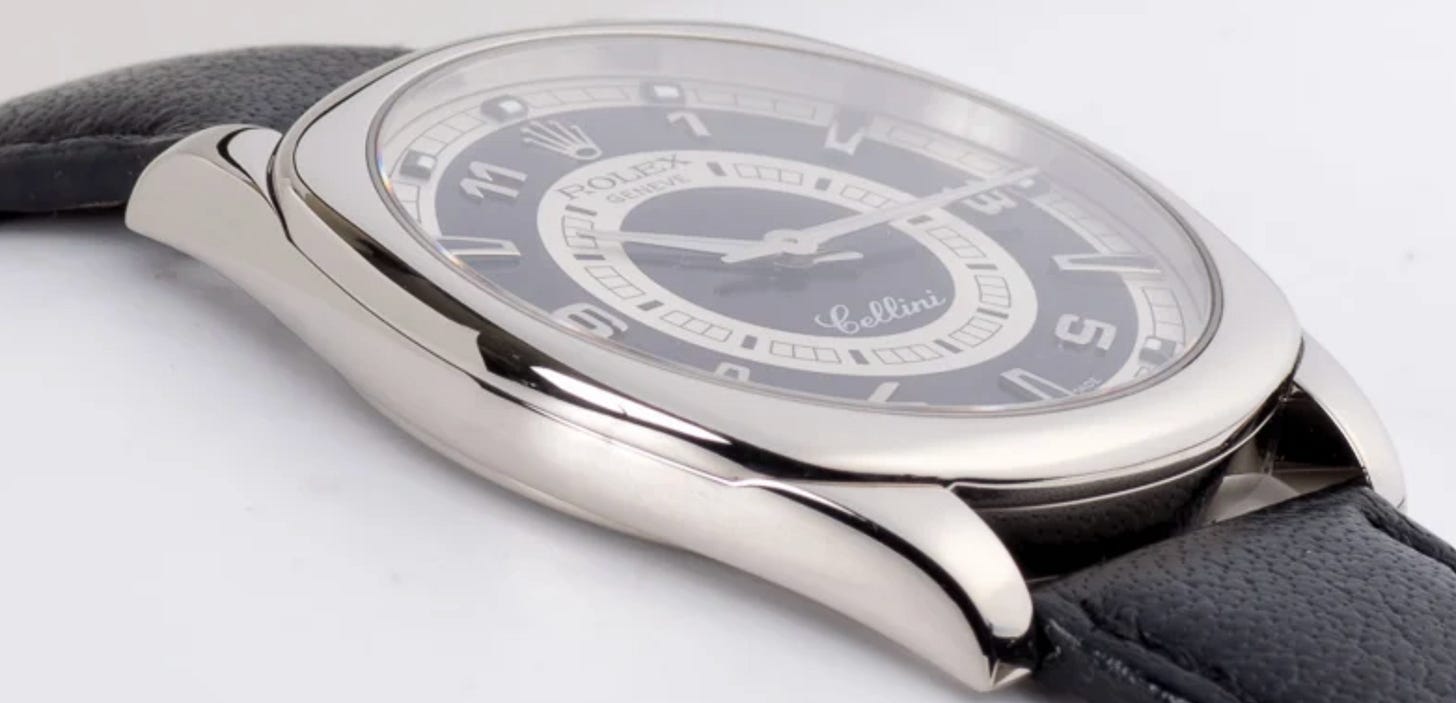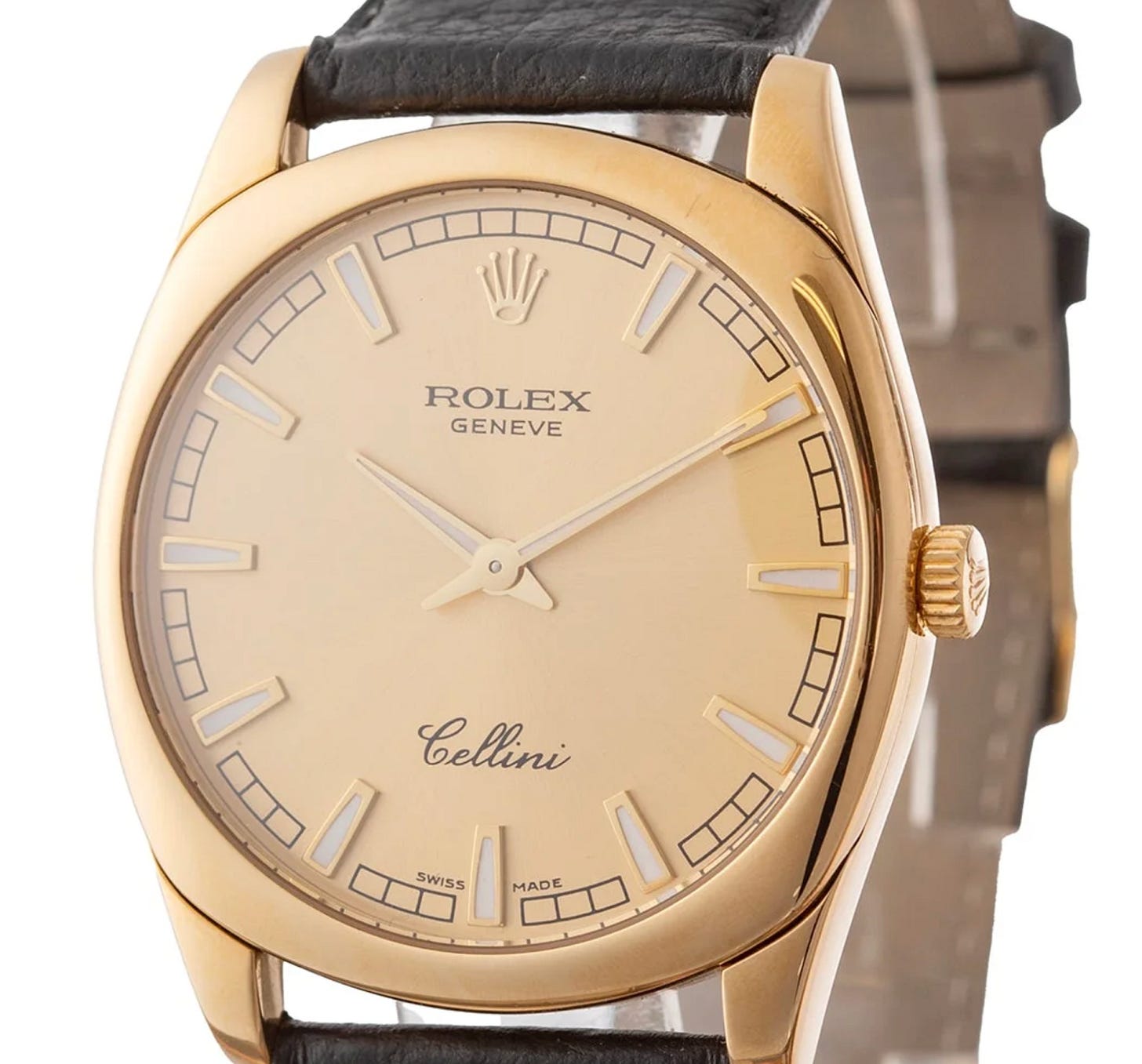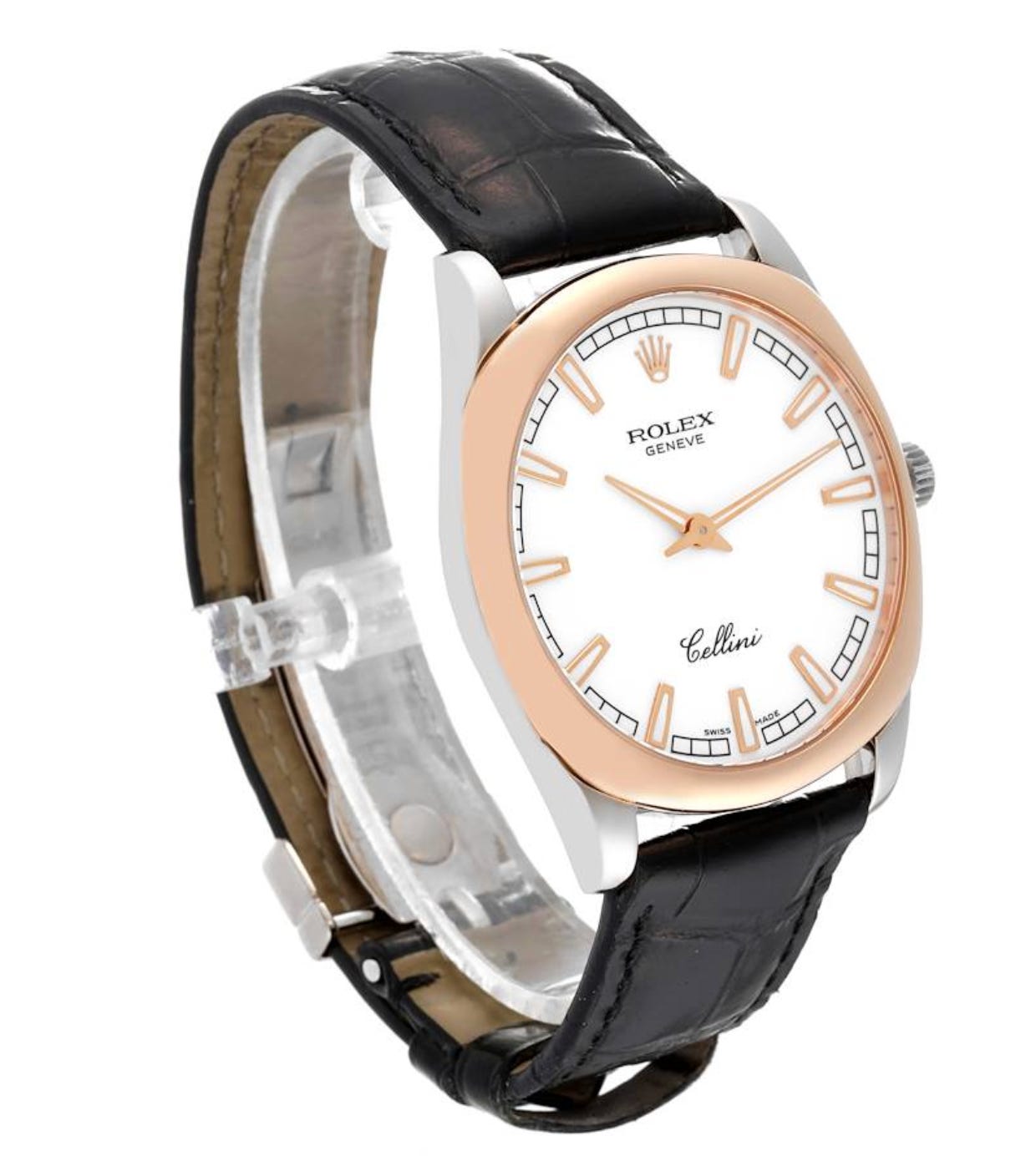When Rolex Lost the Script: The Curious Case of the Cellini Danaos
A Study in Brand Disorientation and Design Overreach.
Among the cultural ruins of luxury’s forgotten artifacts, few pieces so vividly expose the dissonance between brand mythology and lived reality as the Rolex Cellini Danaos Reference 4243. Produced during the late 1990s and early 2000s, this cushion-cased dress watch represents perhaps the most honest expression of Rolex's identity crisis—a moment when the Crown attempted to reconcile its tool-watch DNA with the demands of formal elegance, producing instead a timepiece that satisfied neither constituency while accidentally creating something approaching authenticity.

The design distinction of the Danaos operates through negation rather than assertion. At first glance the case seems circular, but upon closer inspection, you will realize it is almost squared-off with rounded edges—a visual ambiguity that extends to the watch's entire conceptual framework. The 38mm cushion case, crafted in precious metals and fitted with a manual-winding Caliber 1602, represents Rolex's attempt to speak a design language foreign to its core competencies. Yet this very foreignness becomes the piece's distinguishing characteristic: it is recognizably Rolex in its obsessive attention to finishing and proportion, while being utterly un-Rolex in its aesthetic philosophy.

The origin context reveals the Danaos as a creature of institutional confusion rather than market opportunity. As the 1990s rolled in, the Cellini (first introduced in 1968) series shifted from trendy geometric designs to more subdued rounded cases such as the Cellini Danaos and Cestello—a retreat from the bold experimentation of the 1970s toward safer, more conservative territory. This timing proved particularly unfortunate, coinciding with the watch industry's gradual embrace of larger, more assertive case sizes and the emerging dominance of sports watches as luxury statements. The Danaos launched into a market that was moving decisively away from understated dress watches, particularly those priced at luxury levels without offering obvious technical or heritage justifications.

Where signature innovation might be expected, the Danaos offers instead a kind of principled conservatism. The manual-winding movement, the leather strap, the absence of water resistance beyond 50 meters—these were not innovations but deliberate rejections of Rolex's own technological capabilities. Rolex Cellini watches from the 1990s to the 2000s, from the Danaos to the Cellinium, were particularly remarkable because of their 100m water resistance, which was previously found only on Oyster-cased watches—yet this technical advancement felt more like an apology than a breakthrough, acknowledging that even dress watches required some accommodation to contemporary lifestyle demands.
The subcultural relevance of the Danaos presents a more complex picture. Unlike pieces that find unexpected audiences through design or cultural alignment, the Danaos remained largely invisible to both traditional Rolex collectors and dress watch enthusiasts. The Cellini 4243 isn't your everyday watch; and it's certainly not your everyday Rolex—a statement that captures both the piece's intended exclusivity and its actual market irrelevance. The watch failed to achieve meaningful cultural touchstones, remaining a footnote in both Rolex's catalog and broader horological discourse.

Identity clarity becomes the Danaos's most problematic criterion. The piece exists in a state of perpetual equivocation, neither fully embracing Rolex's tool-watch heritage nor successfully establishing an alternative aesthetic identity. This uncertainty extended to its market positioning: too expensive for entry-level luxury, too traditional for design-conscious buyers, too unfamiliar for Rolex loyalists. The watch embodied what might be termed "institutional doubt"—the product of a company uncertain about its own design authority outside its established competencies.
Assessing endurance potential requires acknowledging Danaos's fundamental misalignment with subsequent market developments. As watch culture evolved toward larger cases, integrated bracelets, and sports-watch informality, the Danaos's 38mm proportions and formal aesthetic became increasingly anachronistic. Between June 2020 and June 2022, newer models like the Cellini Time, Cellini Date, and Cellini Dual Time increased in value by 10% to 30%—yet these gains pale in comparison to the explosive appreciation of Rolex sports models, suggesting that even within the dress watch category, the Cellini line remained a secondary consideration.

The rarity with reason analysis reveals perhaps the most damaging aspect of the Danaos legacy. Production numbers remained low not due to manufacturing complexity or material constraints, but due to simple lack of demand. This represents what the DOSSIER framework might term "market-driven scarcity"—the opposite of the "accidental collectibility" that characterizes truly overlooked pieces. The Danaos was rare because it was unsuccessful, not because it was misunderstood.
Scoring poorly across five of the seven DOSSIER criteria, the Danaos emerges as a cautionary tale about institutional overreach rather than a hidden gem awaiting rediscovery. Yet this very failure renders the piece culturally significant in ways its creators never intended. The Danaos stands as physical evidence of Rolex's brief experiment with design humility—a moment when the Crown acknowledged that its aesthetic authority might have limits.
In this light, the Danaos functions less as a timepiece than as a corporate confession: an admission that even institutions possessing seemingly unlimited cultural capital can produce objects that satisfy no one while accidentally revealing something essential about their own limitations. The piece's current market position—neither rising nor falling dramatically, but maintaining a steady, unremarkable presence—reflects its fundamental character: competent, conservative, and profoundly uncompelling.
The ultimate lesson of the Danaos may be that institutional amnesia sometimes serves a purpose. Rolex's subsequent abandonment of the dress watch category in favor of focus on its sports watch strengths represents not cultural loss but corporate wisdom—the recognition that certain aesthetic territories are better left unexplored, and that authenticity sometimes requires acknowledging what one is not, rather than attempting to be everything to everyone.
Bibliography
Altieri, Paul. “In the Spotlight: Cellini 4243.” Bob’s Watches Rolex Blog, August 11, 2021. https://www.bobswatches.com/rolex-blog/watch-review/spotlight-cellini-4243.html.
Bob’s Watches. “Rolex Cellini.” Accessed June 19, 2025. https://www.bobswatches.com/rolex-cellini-1.html.
HODINKEE Shop. “Rolex Cellini Danaos 4243/9.” Accessed June 19, 2025. https://shop.hodinkee.com/products/rolex-cellini-danaos-4243-9-10-10-rol-9b2z0k.
Jaztime. “Rolex Cellini Danaos 4243/9 38mm 18k White Gold Manual BRAND NEW.” Accessed June 19, 2025. https://www.jaztime.com/rolex-cellini-danaos-4243-9-38mm-18k-white-gold-manual-brand-new.
SwissWatchExpo. “Pre-Owned Rolex Cellini Watches.” Accessed June 19, 2025. https://www.swisswatchexpo.com/watches/rolex/cellini/.
SwissWatchExpo. “Rolex Cellini Danaos 18k White Rose Gold Black Strap Mens Watch 4243.” Accessed June 19, 2025. https://www.swisswatchexpo.com/watches/rolex-cellini-danaos-18k-white-rose-gold-black-strap-mens-watch-4243-62694/.
SwissWatchExpo. “Rolex Cellini Ultimate Guide.” The Watch Club by SwissWatchExpo, February 24, 2023. https://www.swisswatchexpo.com/thewatchclub/2023/01/18/rolex-cellini-ultimate-guide/.
About the Author
Sergio Galanti is a journalist specializing in independent watchmaking and mechanical horology.



